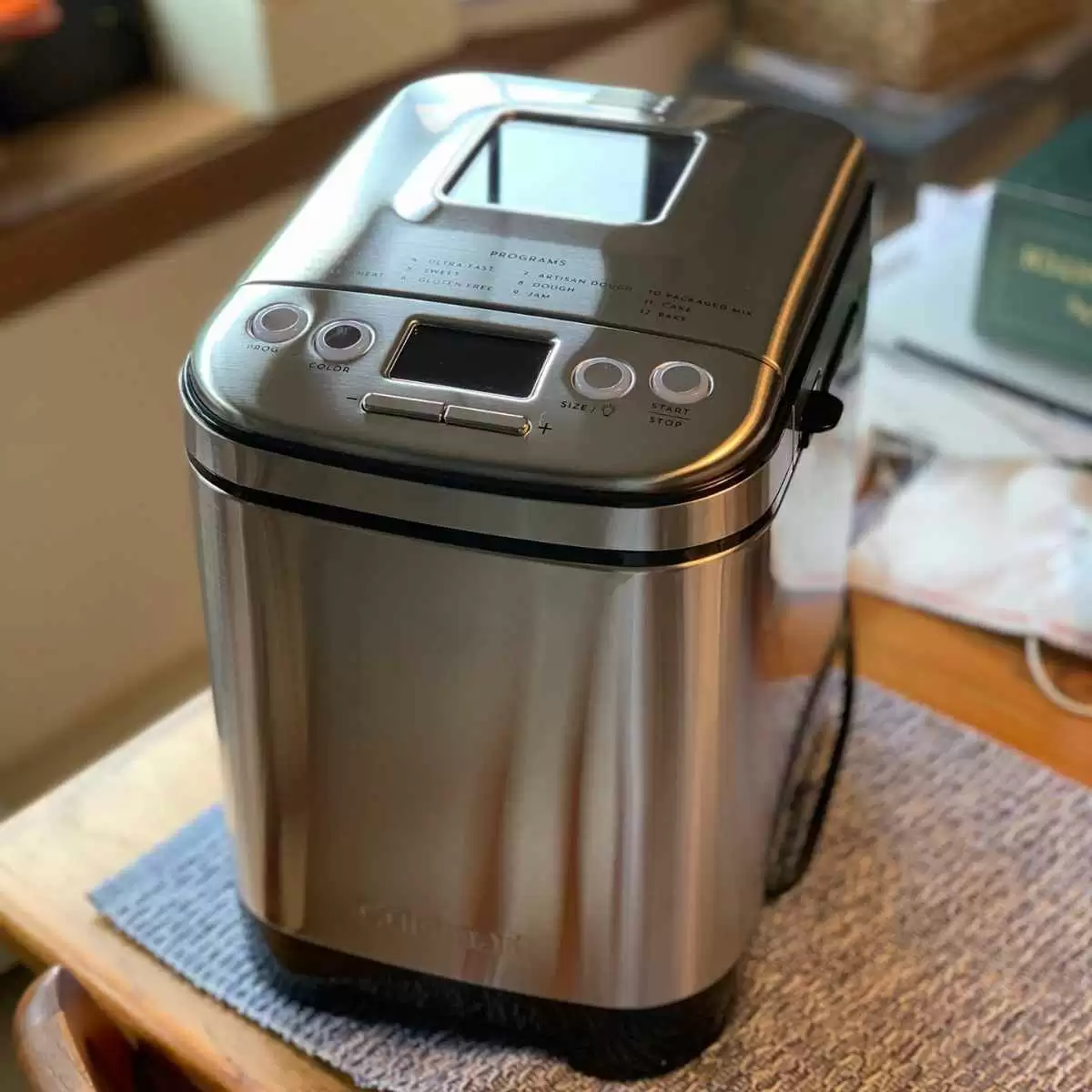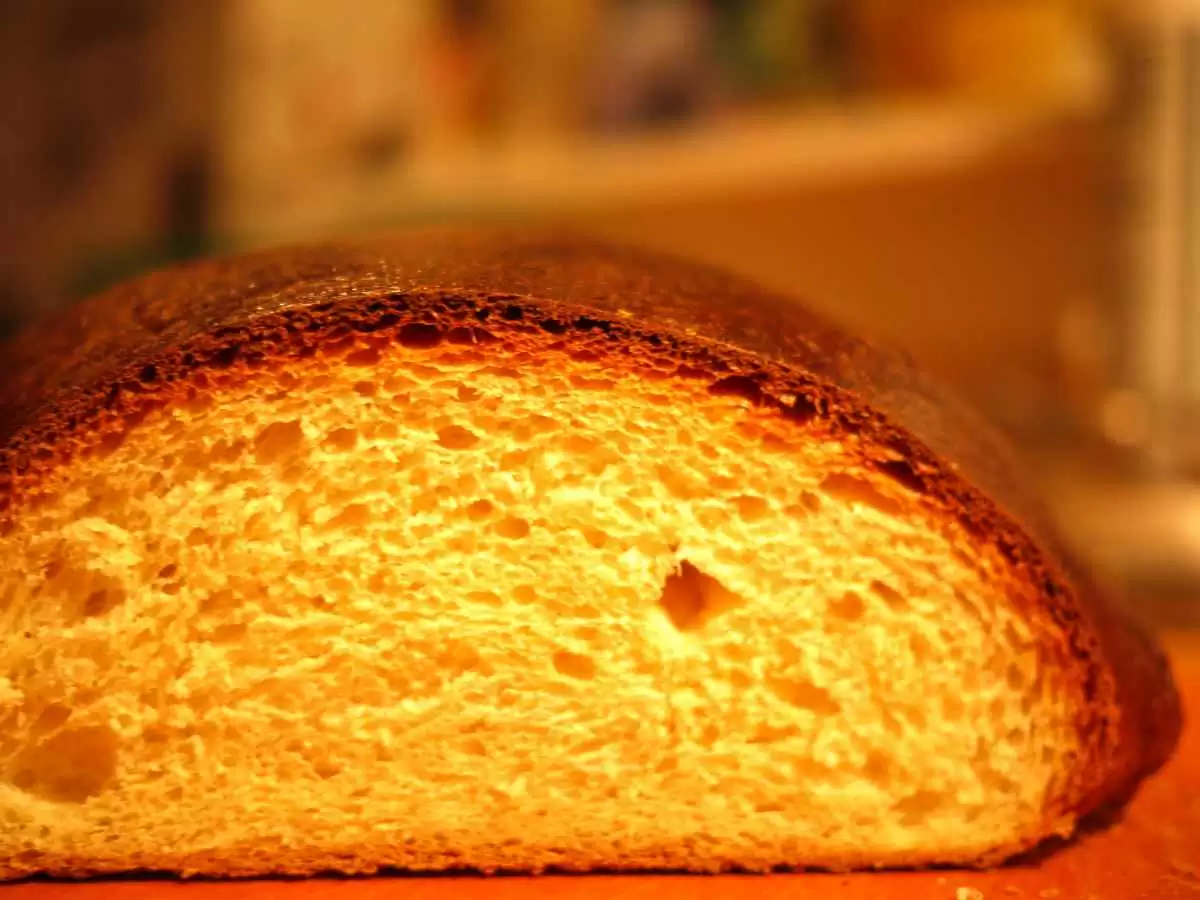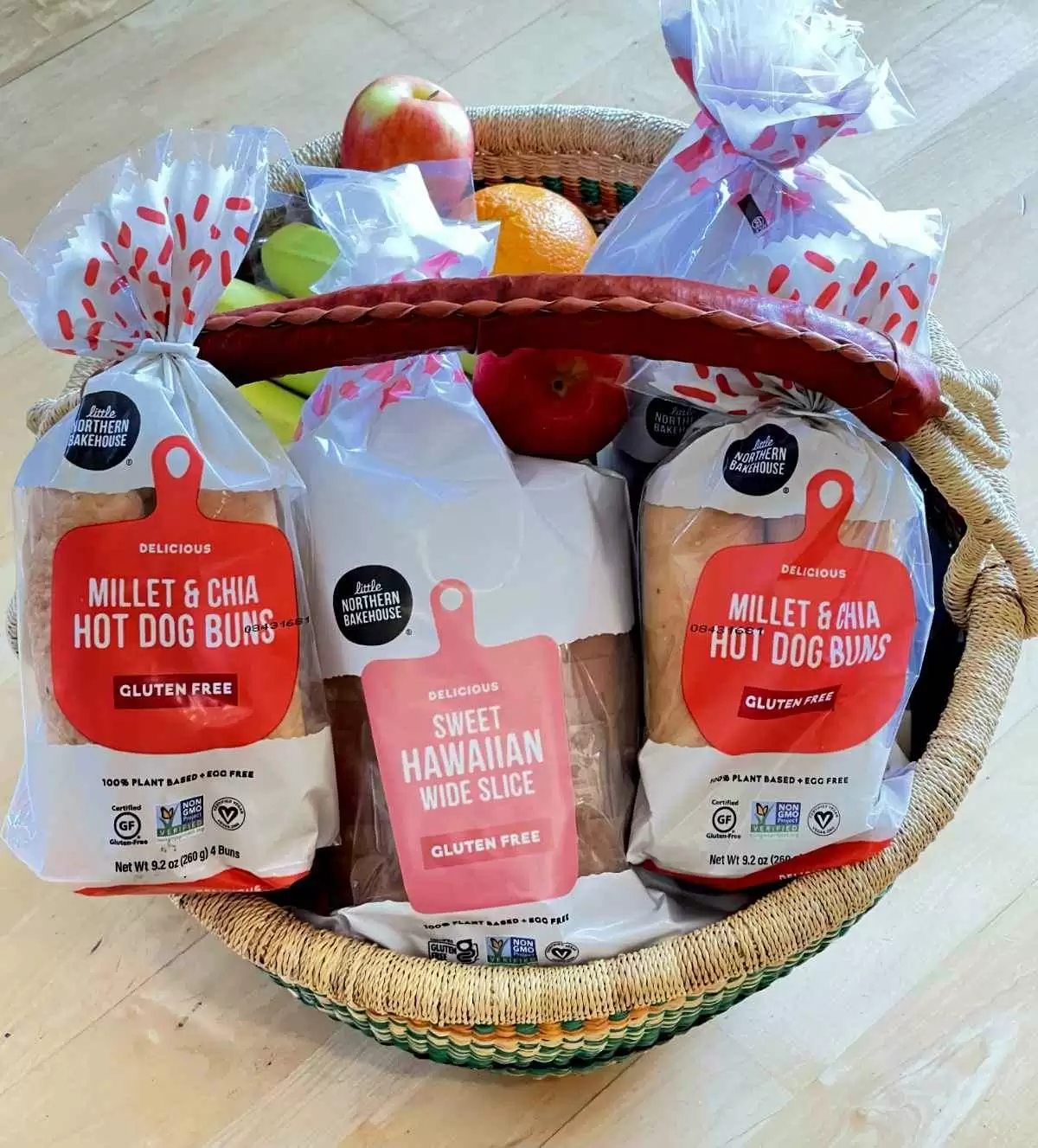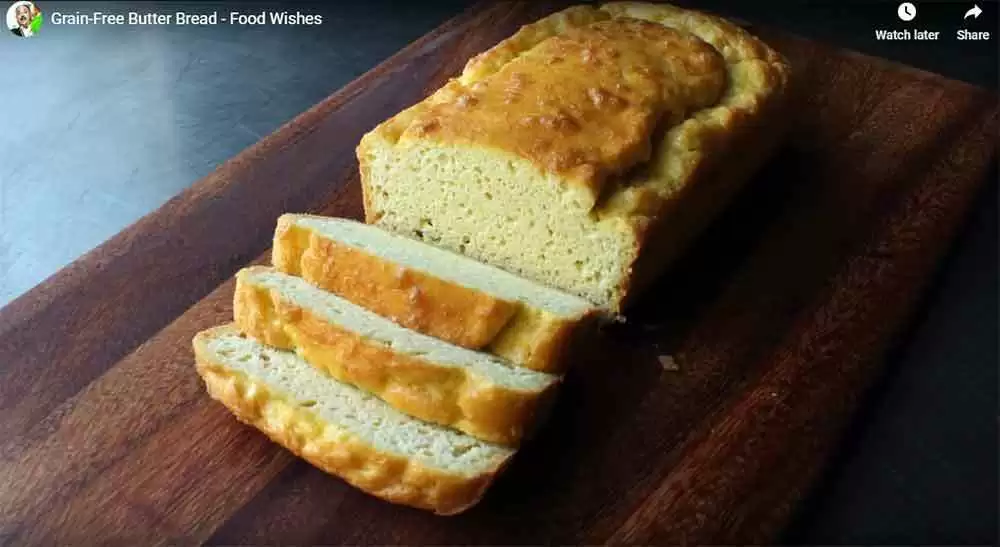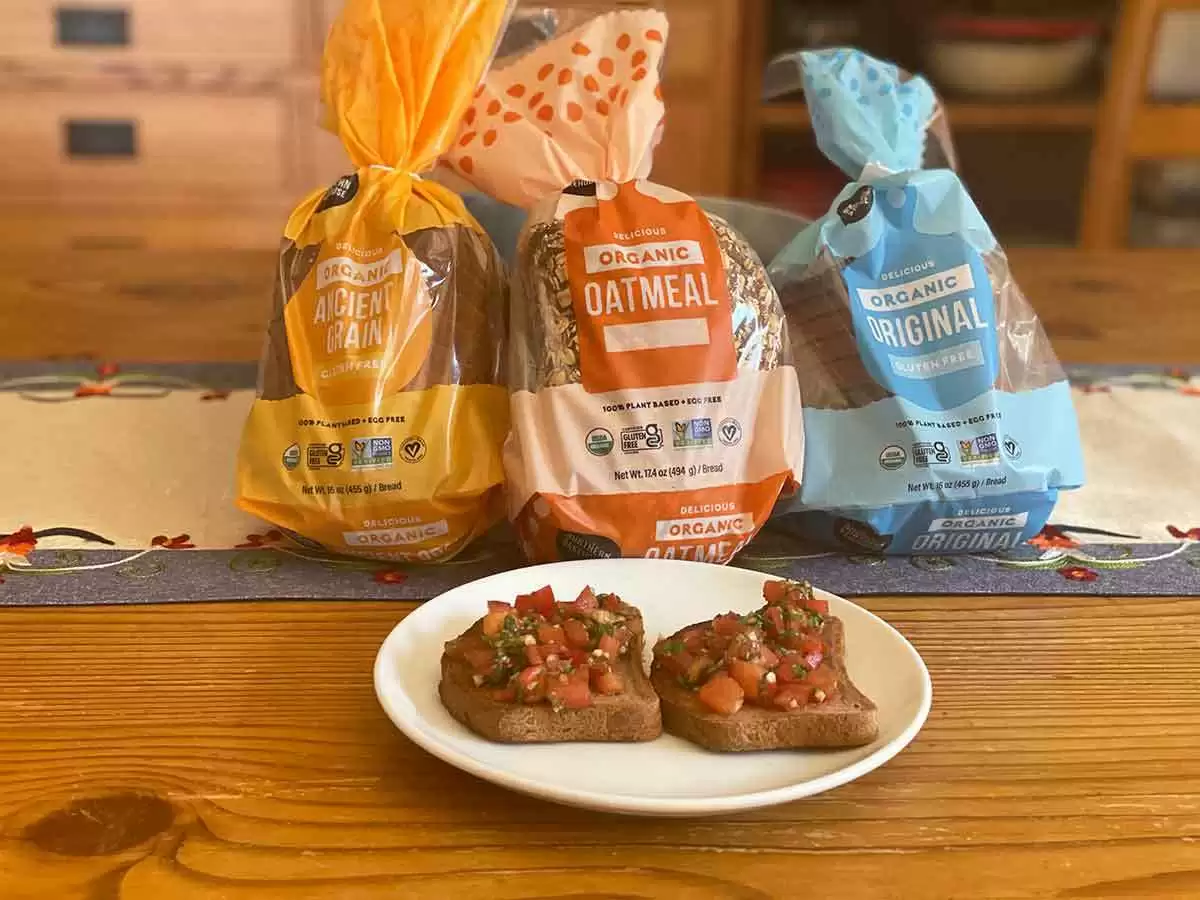-
Welcome to Celiac.com!
You have found your celiac tribe! Join us and ask questions in our forum, share your story, and connect with others.
-
Celiac.com Sponsor (A1):
Celiac.com Sponsor (A1-M):
-
Get Celiac.com Updates:Support Celiac.com!
Search the Community
Showing results for tags 'bread'.
-

Cricket Flour Makes Really Good Gluten-Free Bread
Scott Adams posted an article in Gluten-Free Grains and Flours
Celiac.com 07/28/2020 - Insects offer an edible, high protein alternative to traditional animal-based foods. Insects are consumed in many cultures, but are less commonly eaten in western cultures. One way around that is to produce goods using flour made from dried crickets. A team of researchers has been evaluating ways to use cricket flour effectively to create high quality gluten-free products that are also high protein, and rich in antioxidants. The research team included Lorenzo Nissen, Seyedeh Parya Samaei, Elena Babini, and Andrea Gianottia. They are variously affiliated with the Interdepartmental Centre of Agri-Food Industrial Research (CIRI), Alma Mater Studiorum at the University of Bologna in Cesena, Italy; the Department of Agricultural and Food Sciences (DISTAL), Alma Mater Studiorum at the University of Bologna, Piazza Goidanich in Cesena, Italy. The team fermented doughs using different methods, pH, microbial growth, volatile compounds, protein profile, and antioxidant activity, before and after baking. They then assessed the results against standard gluten-free doughs. They found that the fermentation processes was similar for both cricket-enriched doughs and standard sourdoughs. Cricket flour gave the breads a typical bread flavor profile, marked by a unique aroma that is the result of different levels of volatile compounds, including various amounts of nonanoic acid, 2,4-nonadienal (E,E), 1-hexanol, 1-heptanol, and 3-octen-2-one, depending how the dough was prepared. Finally, antioxidant activities were significantly enhanced in cricket breads, indicating that cricket powder offers gluten-free bakers a way to create flour that is high in protein and antioxidants, and yields high-quality baked products with a desirable aroma. Could flour made with cricket flour become the go-to product for creating gluten-free breads that are nutritious and delicious? Would you try it? Let us know in the comments below. Stay tuned for more on this and related stories. Read more in Food Chemistry- 16 comments
-
Celiac.com 12/14/2023 - People with celiac disease may soon have expanded food options, thanks to research exploring the potential of sourdough to reduce gluten content in bread. A team of researchers from Penn State and Colorado State University, led by Josephine Wee and Charlene Van Buiten, is investigating whether bacteria in the yeast starter used in sourdough bread could help detoxify gluten in other bread products. Gluten, a protein found in wheat, barley, and rye, triggers an immune response in individuals with gluten intolerance and celiac disease. Approximately 7% of the U.S. population is estimated to have gluten intolerance, with 1% suffering from celiac disease. The incidence of celiac disease has been rising by 7.5% annually, mirroring a global increase in autoimmune disorders. The research, funded by a $500,000 grant from the U.S. Department of Agriculture, aims to determine if sourdough starter microbiomes can make gluten-containing bread safe for individuals with celiac disease. Additionally, the researchers are exploring whether these microbiomes can be manipulated to enhance bread quality and safety. Conventional bread dough typically uses baker's yeast instead of naturally occurring yeast and bacteria present in sourdough fermentation. Sourdough bread relies on the fermentation of dough with wild Lactobacillaceae and yeast. The sourdough microbiome, consisting of naturally occurring bacteria and yeast, is critical to this process. The study involves analyzing 500 sourdough starters from around the world to understand the variability in sourdough microbiomes. The researchers hope to leverage whole food microbiomes to develop fermentation technologies that meet consumer demands for high-quality, clean label products with reduced gluten immunogenicity. The term "clean label" refers to making products with minimal ingredients, using recognizable and less processed items. Bread production globally exceeds 100 million tons annually, valued at $201 billion. However, bread is a significant contributor to food waste, emphasizing the need for innovative approaches to enhance quality and reduce waste in bread manufacturing. The research team, with expertise in food microbiology and nutritional biochemistry, aims to uncover the relationship between the sourdough microbiome, bread quality, and gluten immunogenicity. The findings may influence functional outcomes related to bread quality and safety, potentially providing individuals with celiac disease broader food choices. Read more in huntingdondailynews.com
- 1 comment
-
- bread
- celiac disease
-
(and 5 more)
Tagged with:
-
Celiac.com 11/27/2023 - Bread is a staple in many diets worldwide, but people with celiac disease cannot consume traditional wheat-based bread. Additionally, a growing number of people choose gluten-free options due to lifestyle preferences or gluten sensitivity, fueling the market for such products. Pseudocereals like quinoa, amaranth, and brown rice have gained attention as naturally gluten-free alternatives to traditional wheat-based products. In response to the increasing demand for gluten-free products, particularly among individuals with celiac disease, researchers have delved into creating gluten-free sourdough bread with added nutritional benefits. This innovative study, published in the journal Foods, focused on incorporating Moringa oleifera, an unconventional, but health-promoting crop, into the formulation of pseudocereal-based gluten-free bread. The study aimed to evaluate whether enriching gluten-free sourdough bread with Moringa oleifera extract could enhance its nutritional properties. Researchers used pseudocereals—quinoa, amaranth, and brown rice—to create six different gluten-free bread formulations. Three were control breads, each made with one of the pseudocereals, and the other three included Moringa oleifera extract at a 6% concentration in the flour. The formulations were compared against commercially available gluten-free bread on various parameters. The researchers assessed the nutritional composition of the breads, including moisture, protein, fat, fiber, and essential minerals, using standard methods. They also conducted a sensory analysis involving 35 panelists, evaluating attributes such as color, appearance, aroma, texture, taste, general acceptance, and intention to purchase. The findings revealed that the addition of Moringa oleifera significantly increased the nutritional richness of the gluten-free bread. The breads enriched with Moringa exhibited higher protein content, essential amino acids, and essential minerals. Moreover, they demonstrated improved antioxidant capacity and increased levels of soluble dietary fiber, contributing to potential health benefits. Interestingly, the sensory evaluation by the panelists indicated that the novel formulation was acceptable, meeting the criteria for labeling it as a functional food. The study concludes that gluten-free sourdough bread, fortified with pseudocereals and enriched with Moringa oleifera, could be beneficial for individuals with celiac disease, addressing nutritional inadequacies commonly associated with gluten-free diets. Furthermore, the incorporation of Moringa brings forth not only nutritional enhancements, but also potential health-promoting properties to gluten-free bread, making it a suitable option for consumers with and without celiac disease. Read more at news-medical.net
-
Celiac.com 06/26/2023 - Take some of the stress out of back-to-school lunch for your gluten-free kids. When you pack a sandwich on Little Northern Bakehouse White Wide Slice bread, you’re giving them a lunch with all the joy of the real thing—gluten-free AND allergy-friendly. With its fluffy, kid-friendly texture and sizeable slices made with sandwich-making in mind, White Wide Slice proves going without gluten doesn’t mean giving up great taste or settling for a smaller slice. But don’t let that softness fool you. Where the dust-dry breads in the not-so-distant gluten-free history books crumbled like chalk under pressure and failed to support the simplest fillings, Little Northern Bakehouse White Wide Slice loaf aces every school lunch test. These tender slices have the strength to stand up to serious sandwich stacking—or a vigorous bounce around the playground inside your kid’s backpack before the morning bell! (And the substance to satisfy triple-decker teenage appetites, too). On top of being deliciously gluten-free, our White Wide Slice bread is plant-based, Non-GMO Project Verified, and allergy-friendly. With no peanuts, tree-nuts, milk, eggs, wheat, soy, coconut, or sesame, these school-safe slices are perfect for building packable lunches that appeal to kids, picky preteens, and grown-ups alike. School can be tough for gluten-free kids and kids with food allergies—and their parents, too. When you pack a nut-free butter and jam sandwich made with Wide White Slice, you’re giving your kids a lunch that looks (and tastes) just like their friends’ and classmates’ lunches. And that means they can enjoy a moment of freedom to just be a regular kid with a non-weird lunch. And you can send a lunch box love note they can read no matter what grade they’re in. Helping you take the stress out of back-to-school lunch for you and your kids doesn’t end with our gluten-free, allergy-friendly White Wide Slice bread. LittleNorthernBakehouse.com has a library full of recipes, sandwich-packing tips, lunchbox inspiration—and ideas for breakfast, after-school snacks, weeknight dinners, and dessert, too! So, whether you’re packing the first lunch of the school year, or you’re serving strawberry jam on spotlessly white bread for a teddy bear picnic playdate, Little Northern Bakehouse has you covered. Find Little Northern Bakehouse near you.
-

Researchers Seek the Holy Grail of Gluten-Free Bread
Jefferson Adams posted an article in Summer 2023 Issue
Celiac.com 06/13/2023 - While the development of gluten-free baked goods has improved in leaps and bounds over the years, food scientists are still hard at work to find an effective alternative to match the bread-friendly properties of gluten. In chemical-physical terms, gluten is a key protein in baking. It plays a crucial role in giving bread its desired texture and structure. However, for individuals with celiac disease or gluten intolerance, consuming gluten can have detrimental effects on their health. But everyone loves bread, so gluten-free bread has become big business, however no brand has yet found the Holy Grail that is a gluten-free bread which is indistinguishable from traditional bread. One of the problems is air. One of the ways to think of gluten is as a net that keeps dough airy until baking stabilizes the open-pore structure. This net is capable of trapping gas bubbles during fermentation; the stronger it is, the more gas it can hold, and the higher the dough can rise. What has been almost impossible to do so far is to keep the many small gas bubbles in the dough without the supporting gluten scaffold, said Prof Dr Mario Jekle, head of the Department of Plant-Based Foods at the University of Hohenheim in Stuttgart. At the same time, the more the gluten develops, the stronger and longer those interconnected strands become, leading to more chewiness and toughness in the final product. Hence the variation of flours for different applications. Although bread begins with many of the same ingredients as cakes, it has a completely different consistency. Bread flour has a protein percentage of 11%-13%, resulting in a product that is airy and satisfyingly chewy. It's hard to imagine enjoying a chewy cake, so cake flour, with a protein percentage of 7%-9%, has a low gluten-development potential. A common misconception is that gluten is part of flour. Yes, flour contains the two proteins - glutenin and gliadin - necessary to form gluten, but these only join to form that miraculous net when a liquid, like water or milk, is added. In gluten-free baking, lathering up ingredients–creating friction to trap air– isn't a problem. This can be achieved by stirring or using a leavening agent like yeast or baking powder. What gluten-free baked goods lack is the supporting network that holds it all together. However, gluten is a problematic protein for about 2%-3% of the global population. Kneading wheat bread dough. Image: CC0 1.0--rawpixel Gluten Means Disease and Discomfort for the Gluten Sensitive We now know three disease patterns that are related to gluten, said Prof Dr Stephan Bischoff of the Institute of Clinical Nutrition at the University of Hohenheim. The first is celiac disease, which is a widespread chronic autoimmune disease in which the body mistakenly reacts to gluten as if it were a poison. The second is wheat allergy, which is triggered by gluten and similar peptides and is similarly widespread. The third clinical picture is non-celiac gluten sensitivity, where essentially no antibodies are produced, and there does not appear to be damage to the gut lining. What triggers wheat sensitivity, and whether gluten also plays a role, is still unclear. According to Celiac UK, two further gluten-related disorders can be added to the mix. Gluten ataxia is one of a number of neurological manifestations of celiac disease, causing clumsiness, incoordination, slurred speech and sometimes jumpy vision. Another condition, dermatitis herpetiformis is the skin presentation of celiac disease, associated with small blisters on the elbows and knees. No matter the level of intensity, people who cannot stomach gluten have only one remedy in everyday life , which to eat only gluten-free foods. High Fiber from Plants The research team the University of Hohenheim are taking a new approach. Instead of supporting the dough with gluten, Bischoff's team is focused on stabilizing the interface between gas bubbles and dough with alternative proteins. The team is working on extracting protein from peas, rapeseed, rice and maize, that can directly replace gluten protein. Prof Dr Jekle also sees further potential in plant breeding. By precisely defining the optimal parameters to meet their needs, the team hopes to work with plant breeding, in order to target new pea varieties, whose proteins are even better suited to their approach. In another approach, the department is trying to link the natural proteins from rice, maize or oats with mucins (referred to as arabinoxylans) to form chains with gluten-like properties. The scientists also found that naturally-occurring compounds called sapponins found in the cells of quinoa seed or mucilages of cereal hulls–along with the stems, leaves and flowers of daisies–additionally support the formation of an airy dough. It is an approach with additional benefits as, in some cases, it can be used to enrich baked goods with valuable dietary fibre. For example, we know that 30g per day of fiber is already good prevention against colon cancer, one of the three most common cancers in men and women, said Prof Dr Bischoff. The scientists are planning to investigate the use of arabinoxylans in other applications, like meat substitutes. The approach not only gives plant-based products a meat-like structure but additional nutrition from the dietary fibre. So far, there are no comparable products on the market, claim the scientists. The bread rolls currently coming off the mini production line at the University's Technical Centre for Food Science are still small - each comprising 30g of dough, but after being steamed and then baked, the results are light, golden and steaming. The experiment, which uses a hand-width conveyor belt, combines technology with materials science and engineering. However, the challenge is to find the best recipe, as the dough is completely gluten-free, and needs to deliver a final product that is fluffy and tastes good. 3D Printed Bread The department is also working to loosen the dough and combine it with the baking process in one step with the help of 3D printers. A nozzle builds up the pastry together with the pores in millimetre-thin layers, above which, a baking unit immediately solidifies each layer. The process is somewhat similar to the way Salzwedel bakers have been baking the classic Baumkuchen (literally translated 2019) for 200 years. Using a ladle, the Baumkuchen batter is applied in millimetre-thin layers onto a rotating roller and baked layer by layer in front of an open flame. The technology at the University of Hohenheim is, of course, much more sophisticated, flexible and can build many different structures, according to Prof Dr Jekle. His team has been experimenting with 3D printing for several years and in principle, almost any food–from bread to meat to plant-based products, can be produced by this piece of equipment. 3D printing also has advantages that extend from personalized nutrition to sustainability and limiting food waste. With printed foods, we can personalize meals, meaning we can tailor the ratio of fats, carbohydrates, proteins and all other components to exactly meet the personal needs of individuals, said Prof Dr Jekle. And I can also obtain some of the raw materials from residual materials that are created during food production, for example. Read more at bakeryandsnacks.com- 4 comments
-

Psyllium Improves the Quality and Shelf Life of Gluten-Free Bread
Scott Adams posted an article in Latest Research
Celiac.com 08/09/2021 - Improving the quality of shelf stable gluten-free bread is an ongoing mission, and psyillium husk powder has shown some early promise. A team of researchers recently set out to assess the ability of psyllium husk powder to improve the quality and shelf life of gluten-free bread. The research team included Camilly Fratelli, Fernanda Garcia Santos, Denise Garcia Muniz, Sascha Habu, Anna Rafaela Cavalcante Braga, and Vanessa Dias Capriles. They are variously affiliated with the Department of Biosciences, Institute of Health and Society (Campus Baixada Santista), Federal University of São Paulo, Rua Silva Jardim, Brazil; the Department Research, Pro Rectory of Research and Post-Graduation, Federal University of Technology in Paraná, Brazil; the Department of Chemical Engineering, Campus Diadema, Federal University of São Paulo in Brazil. The researchers tried gluten-free bread mixtures containing about 3%, 7%, and 17% psyllium by flour weight. They then compared the performance of their bread to control gluten-free bread and to wheat bread. Using a 10-cm scale, they measured crumb moisture and firmness, microbial safety, and sensory acceptability at 0, 24, 48, and 72 hours after production. They found that crumb firming was common during the storage period, especially for the control gluten-free bread, which had a crumb firmness eight times higher than the wheat bread. Psyllium husk reduced the crumb firmness by 65–75% compared with control gluten-free bread over the 72 hour storage period. The mixture containing 17% psyllium husk showed the longest delay in bread staling, and was well accepted during 72 hours of storage, with acceptability scores for aroma, texture, and flavor resembled those of wheat bread. The results showed that the addition of approximately 17% psyllium husk yielded gluten-free bread with structure, appearance, texture, and acceptability similar to wheat bread, with delayed bread staling during 72 hours of storage. The research team suggests that this approach might yield softer, chewier, better tasting gluten-free breads that stay soft longer. Read more in Foods 2021, 10(5), 954- 19 comments
-
Celiac.com 05/05/2023 - Gluten-free products have become hugely popular in recent years, creating an opportunity for food companies to capitalize on this growing market. However, removing gluten from bread and bakery goods poses a significant technological challenge, as gluten is an essential component of the wheat dough system that gives baked goods their desired characteristics. Without gluten, bread often falls flat in terms of quality, elasticity, texture, and overall customer favorability. Creating a gluten-free bread that's like real bread is like a Holy Grail for gluten-free bread makers. Fortunately, researchers have been exploring alternative protein sources to compensate for the lack of gluten in gluten-free products. One promising option is dairy proteins, which have functional properties that can potentially mimic the protein-network structure of gluten. In a recent study, researchers examined the impact of adding different levels of dairy products, at 10% and 20% weight for weight, to gluten-free bread formulas. They found that the addition of dairy products improved the dough rheology properties, which in turn led to better bread quality parameters such as volume and firmness. The researchers also discovered a strong linear correlation between the pasting properties parameters, as measured by viscosity and elasticity, and bread staling rate, indicating that the use of dairy products has the potential to generate bread with a longer shelf-life. Overall, the results of the study demonstrate that the addition of dairy products to bread and bakery ingredients can significantly improve the technological properties of gluten-free bread. This finding is good news for those who suffer from celiac disease or gluten intolerance and must rely on gluten-free alternatives to stay healthy. As the market for gluten-free products continues to grow, there is a huge financial upside for companies to develop high-quality gluten-free options that are comparable in taste and texture to their gluten-containing counterparts. The use of dairy proteins as a substitute for gluten is a promising avenue for research and development in this area. Obviously, companies need to work information like this into their own research to fully understand the potential of dairy proteins as a replacement for gluten in their products. However, studies like this one offer valuable insights into the potential technological advantages of using dairy products in the production of gluten-free bread. Here's to a future with where gluten-free bread tastes more like traditional bread. Read more in Frontiers in Nutrition
- 3 comments
-
Celiac.com 05/10/2023 - Panzanella is an Italian dish that is basically an herb and mixed green salad with toasted bread mixed in. But, don't be fooled by its seemingly simple ingredients—panzanella bursts with a symphony of flavors that will awaken your taste buds and leave a lasting impression on your guests. Each bite offers a refreshing medley of textures, combining the crispness of the greens, the crunchiness of the bread, and the juiciness of ripe tomatoes. As you savor the exquisite balance of tangy balsamic vinegar, fragrant basil, and aromatic garlic, you'll find yourself transported to a sun-soaked Italian garden, where every ingredient sings in harmony. Ingredients: ½ small loaf gluten-free bread, preferably stale sourdough (but about 12 ounces of any good, toasted bread will do) 4 tablespoons olive oil, divided 2 tablespoons white wine vinegar 2 teaspoons Dijon mustard Kosher salt and pepper 2 scallions, white and light green parts finely chopped, dark green parts thinly sliced (diced red onions can also be used) 2 Persian cucumbers, smashed, halved lengthwise and then sliced 1 cup of dice ripe tomatoes ½ cups fresh or frozen peas (thawed if frozen) 2 cups mixed fresh herbs (such as parsley, basil, mint, dill) 5 ounces mixed greens Directions: Heat oven to 400°F. Cut crusts off gluten-free bread and tear bread into large pieces. On rimmed baking sheet, toss bread with 1 tablespoon oil and roast until golden brown, about 10 minutes. Meanwhile, in a large bowl, whisk together vinegar, mustard, remaining 3 tablespoons oil and ½ teaspoon each salt and pepper; stir in chopped scallions. Add cucumber and tomatoes and toss to coat, then toss with toasted bread. Add peas, herbs and greens and toss gently to combine. Add the toasted bread to the top of the salad, or top each bowl individually. Note: It's also okay to simply make the salad and serve the toasted bread on the side, with butter if you like.
-
- bread
- gluten-free
-
(and 5 more)
Tagged with:
-
Celiac.com 01/28/2023 - Focaccia is the “in” bread these days! It is a cross between pizza and Italian flatbread and is served in many Italian restaurants, along with a plate of extra-virgin olive oil for dipping. Sometimes, the server adds a dash of balsamic vinegar and a sprinkle of dried Italian herbs for a real taste treat. You can recreate this wonderful bread at home with this easy recipe, using my new versatile sorghum flour blend. Sorghum is a nutritious flour that works beautifully in our gluten-free foods. Focaccia is undoubtedly one of my most popular recipes and I know it will become a favorite at your house, too. Carol Fenster’s Gluten-Free Sorghum Flour Blend Use this versatile flour blend for the recipes in Gluten-Free 101: Easy, Basic Dishes without Wheat. You can make your own corn flour (not cornstarch) by grinding cornmeal in a small coffee grinder until it is the consistency of flour. If you prefer almond flour, you’ll find it at Bob’s Red mill (www.bobsredmill.com) or grind blanched almond silvers in the coffee grinder until it reaches a flour-like texture. You can purchase bean flour (either plain garbanzo or a garbanzo/fava blend) at your local health food store. Note: If you use almond flour, you must refrigerate the flour blend. *Makes 4.5 cups 1 1⁄2 cups sorghum flour 1 1⁄2 cups potato starch or cornstarch 1 cup tapioca flour 1⁄2 cup corn flour or almond flour or bean flour or chestnut flour Carol Fenster’s Focaccia Bread Bread Ingredients: 1 1⁄2 tsp. dry yeast 1 1⁄2 cups Flour Blend (pg. 15) 1 1⁄2 tsp. xanthan gum 1 tsp. unflavored gelatin 1 tsp. dried rosemary 1⁄2 tsp. onion powder 3⁄4 tsp. salt 3⁄4 cup warm water (110°) 1 tsp. sugar 2 large eggs 2 Tbsp. olive oil 1⁄2 tsp. cider vinegar Topping 1 Tbsp. olive oil 1 1⁄4 tsp. Italian seasoning 1⁄4 tsp. kosher or coarse sea salt 1) Combine all bread ingredients in mixing bowl. Beat dough with mixer (regular beaters, not dough hooks) for 2 minutes. Dough will be soft and sticky. 2) Transfer dough to greased 11 x 7-inch nonstick pan. Cover with aluminum foil tent and let rise in warm place (75-80º) for 30-40 minutes or until desired height. 3) Preheat oven to 400 º. Sprinkle dough with topping ingredients. Bake 15-20 minutes or until top is golden brown and crisp when tapped with your fingernail. (A sprinkle of Parmesan cheese is optional.) Serves 10. Additional Focaccia Toppings Try these variations for an even more flavorful Focaccia: Herb Focaccia: Combine 1⁄2 tsp. each dried rosemary, sage, and thyme, 1⁄4 tsp. black pepper, and 2 Tbsp. Parmesan cheese. Sprinkle over bread before baking. Sun-Dried Tomato & Olive Focaccia: Sauté 1⁄4 cup minced sun-dried tomatoes, 1⁄4 cup sliced black olives, and 1⁄4 cup chopped onion in 1 tsp. oil. Sprinkle over bread before baking. Pesto Focaccia: Purée in food processor just until smooth, leaving bit of texture: 1 cup fresh basil leaves, 1 garlic clove, 1⁄2 cup pine nuts. With motor running, slowly add 1⁄4 cup olive oil through feed tube. Add 1⁄4 cup Parmesan cheese and dash of black pepper. Spread over bread before baking. Recipes Reprinted from the new Gluten-Free 101: Easy, Basic Dishes without Wheat, 2003 by Carol Fenster, Ph.D. with permission from Savory Palate Press.
-
Celiac.com 12/14/2011 - Finding a slice of pre-packaged gluten-free bread that is 100% enjoyable seems to be the bane of many celiacs. So you finally decide to make your own. You read up on baking breads; you spend money to buy the ingredients; you take the time to prepare the mixture, then you put your creation in the oven. Oh, the wonderful aroma of bread begins to fill the air. You wait in anticipation. Finally, the oven timer goes off and you remove your creation, only to discover that something went terribly wrong! Don’t despair. Below are some of the more common problems and solutions. Bread machines have become very popular. While they are tooted as being time-savers, baking bread in the oven actually takes very little extra time and effort, and usually yields better results. The most common complaint in gluten-free bread-baking is that the top of the loaf is dark brown while the inside is still doughy. If this is a problem for you, try lowering the oven temperature by 25 degrees the next time you bake, and set your oven rack higher. After the loaf is partially baked, cover it with a piece of foil for the remainder of the baking time. A sure-fire way to get the inside to bake thoroughly is to use two small loaf pans instead of one large one. Something else that will cause your bread not to bake through is the density factor, which leads us to issue number two. Number two in the complaint department is that gluten-free breads are too dense and heavy. The alternative flours are heavier than wheat flour, so “tricks” must be played with the dough to obtain lighter, wheat-like results. The use two smaller pans to bake the bread instead of a single large pan will also help avoid this problem by giving the bread more room to expand. You can also use a bit more leavening and sugar (the sugar-to-yeast ratio must remain the same for the bread to rise properly). Use only fresh yeast that is dissolved in warm—not hot—liquid; if the liquid is too hot, the yeast will not rise properly. Another trick is to have all of the liquid ingredients at room temperature, and then whip the liquid ingredients together in a blender to incorporate more air before adding them to the flour mixture. You can also use a little less xanthan gum, and be sure to blend the dough mixture thoroughly, and then knead it a little more. The issue of how much liquid to use to make your bread lighter is much more confusing. If you are using an egg replacer, you may need to add a little more liquid to replace the liquid in eggs. If you use extra large eggs, and your bread is too dense, try using a smaller size egg. For a lighter loaf of bread, use slightly less liquid in the recipe; this also applies if you live at a high altitude. When baking at very low altitudes, slightly increase the amount of liquid. If you are not confused yet, then continue reading! Different gluten-free flours absorb different amounts of liquids. Some alternative flours require that you add more liquid to your recipe to prevent the loaf from being too dry and crumbly, while others require that you reduce the amount of liquid used to enable the loaf to be lighter and less dense so that it will bake evenly all the way through. Now “humidity” quietly enters into the picture. If it is humid, reduce the amount of liquid. Ultimately, only experimentation will determine exactly how much liquid will be needed for the flours you are using. Have you ever taken a perfect loaf of bread out of the oven, only to watch it slowly collapse as it cools? You are not alone. This usually indicates that the bread is not completely cooked inside. The simplest remedy is to use two smaller baking pans instead of one large one. Increase your oven temperature slightly, and slightly decrease the amount of liquid used. After experimenting and adjusting oven temperatures, amounts of liquids used, types of flours used, you finally remove the perfect of loaf bread from the oven. You wait in anticipation for it to cool. You get out the knife to cut your first slice—and it crumbles. Oh, the disappointment! The dough was too dry, resulting in a loaf that will not hold together. First—do not throw out the crumbs! Put them in a small freezer bag and freeze them for the day when you want to make bread dressing, croutons, a crumb topping for a casserole, or breadcrumbs to coat fish, chicken or pork chops, or for use in a meatloaf. To avoid the crumbling when you make bread in the future, reduce the amount of flour mixture slightly. Add a little more binding by increasing the amount of xanthan gum or dough enhancer. Use milk (cow, soy or rice) in place of the water called for in the recipe. Once the bread is baked, cool the loaf completely before slicing it with a serrated knife that has been sprayed with a gluten-free nonstick spray. There are many variables when baking with gluten-free flours and yeast. The important thing to remember is that the “real” taste of bread is achievable. All the time spent in trial and error will be worth it—enjoy! No-Knead Toasting Bread This bread slices without crumbling, is moist, and is perfect for toasting! Ingredients: 3 eggs 1 ½ Tbsp. warm water 1 Tbsp. quick-rising gluten-free yeast ¾ tsp. sugar ¾ cup milk 2 cups gluten-free flour mixture ½ tsp. gluten-free baking powder 1 tsp. cinnamon ¼ tsp. salt ½ cup + 1 Tbsp. sugar ¼ tsp. cider vinegar 2 tsp. gluten-free mayonnaise 4 Tbsp. butter, melted ½ cup gluten-free flour mixture* 1 egg 1 Tbsp. sesame seeds Directions: Place 3 eggs in a bowl of warm water for 10 minutes. In a small bowl, stir together the 1 ½ Tbsp. warm water, yeast, and ¾ tsp. sugar; set aside for 15 minutes. Scald milk, then let it cool till lukewarm. Sift together the 2 cups flour mixture, baking powder, cinnamon, salt, and sugar; set aside. In a mixer bowl, mix together vinegar, mayonnaise, eggs and melted butter. Add the yeast and milk and beat until smooth. Slowly add the flour mixture, beating at low speed until blended. With a spoon, stir in the remaining ½ cup of flour mixture. Generously spray a loaf pan (9X5”) with gluten-free nonstick spray. Spoon the batter into the pan. Dip a spoon in a little gluten-free flour and use the back of the spoon to smooth the dough in the pan. Whip the remaining egg with a few drops of warm water, then brush this egg mixture on top of the loaf. Sprinkle loaf with sesame seeds. Spray one side of a piece of waxed paper with gluten-free nonstick spray; cover loaf with paper, sprayed side down. Place a bowl of very hot water on the bottom shelf of the oven. Place the loaf pan on the shelf above the water. Close oven door and let the dough rise for 1 hour. Remove water and loaf pan from oven. Preheat oven to 350F for 10 minutes. Remove waxed paper and place bread in oven to bake for 25 to 30 minutes. If the top of the bread is browning too quickly, cover pan with a sheet of foil until loaf is baked through. Let baked bread sit in pan for 5 minutes, then remove bread and let it finish cooling on a wire rack. If you are not going to be eating the bread the day you bake it, wrap it well and freeze it. Spray a serrated knife with gluten-free nonstick spray to cut the bread. *Gluten-free Flour Mixture: The flour mixture I use is a combination of rice, potato starch, tapioca and garbanzo bean flours, cornstarch and xanthan gum. If you are allergic to any of these products, alternative flours may be substituted.
-
Celiac.com 12/13/2022 - Being gluten-free presents some challenges for Catholics with celiac disease, especially if they cannot receive the host via the chalice, as was the case during the height of the Covid epidemic. We've done a few articles off gluten-free communion wafers, and on the church rules around them. Communion Bread Must Contain "Some" Wheat Catholics with celiac disease who hope to take communion in the form of gluten-free bread or wafers are likely hoping in vain, because according to church law, all bread that is consecrated at the altar must contain a percentage of wheat. The latest confirmation of this reality comes via Sister Fiachra Nutty, from St Mary’s Abbey, in Waterford, Ireland. Sister Fiachra’s job up until September of 2020 was baking and selling holy bread. The pandemic has "made some of our work redundant, our primary work here is prayer,” she said on RTÉ Radio 1’s Liveline. Before the pandemic, Sister Fiachra was working on Eucharist bread. She said she made five different sizes of bread both in brown and white. But there was never a gluten-free option. "We don’t do gluten-free,” she said. “That is by canon law that the bread that's concentrated at the alter must have a percentage of wheat, so we can't produce gluten-free hosts and be in conformity with canon law." She acknowledged the existence of gluten-free hosts, but noted the law. "Now, there are gluten-free hosts out there and I’m not trying to cause trouble with anybody but under canon law it's not supposed to be concentrated." Celiacs Should Take Communion from the Chalice She advises Catholics with celiac disease to consider that, absent the bread or wafer, they can choose to receive from the chalice. People who "have a problem with gluten...should really be receiving from the chalice. I know we can’t now but pre Covid.” The rule that communion hosts must contain gluten has presented challenges for numerous Catholics looking to receive communion. How much the practice of conferring host and chalice at mass has changed back to its pre-Covid ways remains unclear. Perhaps Catholics with celiac disease who take mass can chime into our comments and let us know the disposition of the host and chalice in your local parish, both pre- and post-covid. Certainly, for Catholics looking to receive communion via the host, this news will likely be unwelcome, and possibly present some challenges to receiving communion. There is also a possibility of ingesting cross-contamination when drinking from a chalice that has been shared with others who have just eaten a gluten-containing host. Are you Catholic? Have you run into this problem in your local parish? Please share your thoughts in the comments below. Read more at independent.ie
-
Celiac.com 11/26/2022 - Longing for soft, warm and delicious gluten-free breads? Then consider a bread machine, one of the most popular kitchen appliances—perfect for our home made gluten-free breads. When you think of it as a small oven, free of drafts and temperature changes it is easy to understand how it can turn out beautifully risen breads with great texture and remarkable taste. There are many benefits to using a bread machine, including: Frees up regular oven for other uses Keeps kitchen cooler Saves money on electricity Move it around the kitchen, put it in your camper or take it to your dorm Avoids cross contamination Lends itself to creativity in the kitchen Safer for younger family members to use Less expensive than purchasing a second oven Perfect for those who have had difficulties with yeast breads rising in the oven Success Starts with Purchasing the Right Bread Machine for your needs Before you make your purchase, answer these questions: What is your budget? Bread machines run from $29.99 through $249.99. The good news is all price ranges offer the required features for successful gluten-free breads. How much space do you have? Sizes vary considerably. Measure the space where you will be using the bread machine. Some machines have shorter cords than others so notice the distance to electrical outlets. Remember you must have enough clearance space to be able to open the bread machine lid. Do you want a bread machine that is fully programmable or one that may require you to manually change the settings during the baking process? The more programmable the machine, the more money it will cost. The most programmable machine is the Zojirushi BBCC-V20. It retails for about $249.00, so it is best to try to find it on sale. Bread machines with less programmability, such as Oster, Toastmaster, Welbilt, ($50 - $60 price range) also bake great bread. You will need to manually change the programming from the one hour Dough Cycle to the one hour Bake Cycle, unless you use the No-Knead No-Rise Method. Bread Machine Features: The most important features are the two cycle indicators: Dough Cycle and Bake Cycle. You will need both. Are indicators easy for you to locate and read? Do not purchase a machine if the cycle indicators are hidden under the lid or are too small to read. Look for a large window. You will want to know if the bread is mixing well, or if it has risen to its full height, all without lifting the lid. Purchase a bread machine that will handle 11⁄2 to 2 pound loaves for the sake of versatility. Open the box and look at the bread pan inside the bread machine. Does it pop out or twist? Is the pan easy for you to operate? Open the box and look at the bread pan inside the bread machine. Does it pop out or twist? Is the pan easy for you to operate? Some of the most common questions I receive about purchasing a bread machine: Does gluten-free bread have to rise more than once? No. One rise is sufficient. That is why we recommend the Dough Cycle and the Bake Cycle rather than the full cycles. Does gluten-free bread have to knead? This is a matter of semantics. It does not have to ‘knead’ since there is no gluten. However, it does have to be fully mixed. Our experience, after baking over 500 loaves of bread, all in bread machines, is that using the Dough Cycle provides sufficient mixing time. What are your favorite bread machines? This is tough since models keep changing. I have used over 8 different styles of bread machines, and every one of them has their good and their “Gee, I wish this was different” features. This is no different from the other tools we use in the kitchen, our sewing machines or even tools in our tool box. My three favorite machines are the Zojirushi BBCC-V20, the Welbilt ABYK and an old round bread machine that I purchased at a garage sale. Prices I paid were $169.99, $39.99 and $5.00, respectively. How long a bake time should I look for in a bread machine? I recommend a 60 – 90 minute bake time option. This is not available in every machine style. If the model you like only has a 60 minute bake cycle, see if you can restart the Bake Cycle after the 60 minutes are over, just in case the bread is not done. Do breads usually take longer than 60 minutes to bake in the bread machine? Just like your full oven, it depends on the bread recipe. Fruits, vegetables or heavy flours may take longer to bake. Is the Add-in ‘Beep’ feature necessary? My technique is to add all wet ingredients in the beginning, this includes the fruits and vegetables, since they contain water which will affect the water to flour ratio. Dry ingredients, such as nuts, seeds and cheese can be added at the beep. You will develop your own style. Making a decision on which machine to purchase and learning how to operate your bread machine may take about one to two hours of your time, but it is well worth the effort—as the reward will be great gluten-free bread!
- 2 comments
-

Bread Baking Success in the Bread Machine (or Oven)
LynnRae Ries posted an article in Autumn 2003 Issue
Celiac.com 10/29/2022 - The bread machine is a great tool for everyone’s kitchen, dorm room or camper, but what happens once you plug the machine in and add the ingredients? Some people, like one of the testers for Delicious Gluten-Free Wheat-Free Breads, simply add all the ingredients to the bread pan, close the lid, hit the programmed buttons and walk away. An hour or two later they return to a great tasting, freshly baked loaf of gluten-free bread. These free-style bakers do not worry if an edge of the loaf shows flour that is not totally mixed together or if the bread crust is not totally smooth with a nice rounded top. Then there are people who love to peek, prod and perfect their bread baking techniques into an award winning loaf of bread. Perhaps you fall somewhere between these descriptions. Either way, you will enjoy these Best Bread Baking Tips. Peek You can ‘peek’ at how well your bread machine is mixing the dough by either lifting the lid, or looking through the window. Reasons to peek include: adding of liquid; adding nuts or seeds during the beep; simple curiosity or you just can’t keep your hands off the equipment. Another reason to peek is to verify the bread is rising, or to determine if it has risen enough. Try to not raise the lid during the rising cycle. If your machine has a small window, shine a flashlight into the window to avoid raising the lid. Prod You may wonder why some people ‘prod’ the dough. Think of it as another term for helping the dough to mix. The ultimate goal is to have the dough appear silky and spread to the sides of the bread pan with just a hint of a bump or dome over the paddles. In some of the recipes you may even see paddle marks in the dough. Perfect Hints for perfecting the bread: Before you remove the bread from the pan, verify it is done. Tap on the top of the loaf. It should sound hollow. The bottom should also sound hollow. This works for both bread machines and oven made bread. Sometimes paddles stick inside the loaf when removing the bread from the pan. Do not worry. Use a toothpick to loosen the bread from around the paddle. Do not use a knife as it will remove some of the non-stick coating from the paddle. If you leave the paddle inside the bread until it cools, stick a toothpick with a flag on it (purchase at your craft store) into the top of the loaf. That will remind you to remove the paddle before you start cutting. Wait at least two hours before cutting your bread to allow the bread to finish baking. This is called carry over baking. Use an electric knife or serrated bread knife for cutting the bread •Save the bread crumbs from cutting for meatballs, meatloaves or to sprinkle on salads. Lastly, double wrap and freeze the bread you will not be eating within the next couple of days. The best method I have found for thawing and warming up the bread is to pop the slices into a 150°F oven for a minute or two. You will be pleased at how fresh the bread feels and tastes. Portuguese Sweet Bread from Delicious Gluten-Free Wheat-Free Breads by LynnRae Ries. One taste of this bread and you will know why it is recognized as one of the great traditional breads. Wet Ingredients: 3⁄4 cup eggs 3⁄4 cup water, more or less as needed 1⁄2 cup sweetened condensed milk – NOT evaporated milk 1 teaspoon rice vinegar 2 Tablespoons olive oil 1⁄2 teaspoon grated lemon rind 1 teaspoon vanilla extract Dry Ingredients/Flour Mixture: 1 cup white rice flour 1⁄2 cup tapioca starch flour 1⁄2 cup potato starch 1⁄2 cup cornstarch 1⁄2 cup sweet rice flour Other Dry Ingredients: 1 teaspoon salt 1⁄4 cup dry milk powder 1 teaspoon egg replacer 1 Tablespoon xanthan gum 1⁄2 teaspoon ground nutmeg (optional) 2 1⁄2 teaspoons yeast Directions: Put ingredients into the bread pan in the order recommended by the manufacturer (usually all the wet ingredients go in first, then the dry and the yeast is sprinkled on top). Set your machine for Dough (to mix and rise) and then to Bake. Walk away or Peek and Prod. This bread will remind you of the Hawaiian Sweet Bread or Pan de la Luce. -

Easy Irish Soda Bread (Gluten-Free)
Jefferson Adams posted an article in Bread Recipes (Gluten-Free)
The season of green is upon us once again and a Saint Patrick’s Day celebration wouldn’t be complete without a hearty piece of Irish soda bread. Reminiscent of a large scone, this recipe yields delightfully sweet bread. My Irish friends tell me a good crumbly piece of “Leprechaun Bread” goes great with a sharp cheddar cheese. I think a dab of butter and sprinkle of cinnamon is a nice topper as well. Ingredients: 1 cup brown rice flour ¼ cup tapioca flour ¼ cup potato starch 1 teaspoon xanthan gum 1 teaspoon baking powder ½ teaspoon baking soda ½ teaspoon unflavored gelatin ½ teaspoon nutmeg ¼ cup buttermilk 6 tablespoons melted butter 1 tablespoon honey 1 egg, beaten ½ cup raisins or currants, soaked in hot water for 10 minutes Directions: Preheat oven to 350° F and line a standard loaf pan or baking dish with parchment paper. In a large bowl, combine all dry ingredients until well-incorporated. In a second bowl, stir together buttermilk, butter, honey, egg and soaked raisins. Hollow out a small well in the dry ingredients and slowly pour in the wet mixture. Stir until combined and sticky. Form into a loaf and transfer to baking pan. Cook for 35-40 minutes until a knife inserted in the middle comes out clean. Let cool and remove from parchment-line dish. -
This recipe comes to us from Barbara Paull. Ingredients: 8-10 medium green tomatoes 2/3 cup boiling water ½ cup raisins 2/3 cup vegetable shortening 2 - 2/3 cup sugar 4 eggs 3 - 1/3 cups gluten-free flour mix (equal amounts of garbanzo, oat, potato, tapioca, rice and brown rice flours – Note that not all celiacs include oats in their diets.)* 2 teaspoons baking soda 1 ½ teaspoon salt ½ teaspoon gluten-free baking powder 1 teaspoon cinnamon 1 teaspoon cloves 2/3 cup pecans or walnuts (coarsely chopped) *Most gluten-free flours will work. Yields 2 loaves. Directions: Slice green tomatoes, cut in quarters, run through blender until creamy. Need 2 cups pulp for recipe. Soak raisins in boiling water. Set aside to cool. Cream shortening, sugar, and eggs in large mixing bowl. Add pulp, raisins and their water. Beat well. In separate bowl, combine flour, soda, salt, powder, cinnamon, cloves, and nuts. Add one cup at a time to tomato mixture. Stir well each time. Divide into 2 - 9” x 5” greased loaf pans. Bake at 350F for 1 hour. Possibly 10 minutes more (I turned oven off after 1 hour and left it in for 10 minutes more.).
-
We got some "gluten free" English muffins from trader Joe's and they made me quite sick from gluten. The latest post about trader Joe's bread being questionable was from 2018. They're new locally and I was hoping their gluten-free processes had improved in the years since I last lived near one, but I'm paying a heavy toll for that hope. Whatever their practices and contamination levels this is what I would call severe exposure, certainly gluten, and worse cross contamination than I've experienced in years. Hopefully someone else will skip trying trader Joe's brand "gluten free", I'm certainly not risking any of their bread.
- 4 replies
-
- bread
- contaminated
-
(and 4 more)
Tagged with:
-
i really want to make taro bread i can share with my best friend, but the recipes i find online all have regular flour in them. im not the best baker in the world, ive only made 5 loaves in my life, so i need either to be walked through the process of using gluten free flour, or i need a recipe that doesnt need a substitution. last time i tried to use gluten free flour i somehow made slimy hard "bread" :( please help! i love her so much and i never know what to feed her when she visits! thank you so much!
-
Celiac.com 06/01/2022 - Have you noticed that many gluten-free sandwich breads are made too small to make a real sandwich, or that most gluten-free hot dog buns are dry and too short for a hot dog? Thankfully this isn't the case with Little Northern Bakehouse's Millet & Chia Hot Dog Buns, and their all new Sweet Hawaiian Wide Slice Bread—both of these products are big! In fact, each slice of their Sweet Hawaiian Wide Slice Bread is large enough to make a real, full-sized sandwich, while their Millet & Chia Hot Dog Buns are actually slightly longer than a standard hot dog. Little Northern Bakehouse's new Sweet Hawaiian Wide Slice Bread is magnificent! It has a slightly sweet taste—just like real Hawaiian bread—and its slices are not just large, but also thick, just like the real thing! This new bread is part of their top selling "Wide Slice family," and is launching in Sprouts on June 1st, followed by a nationwide distribution. It was also named the Best New Vegan Bread at Expo West. I heated my Millet & Chia Hot Dog Bun in the microwave for 10 seconds before adding my boiled hot dog, which made the bun warm and slightly chewy, and I swear that it tasted just like the real thing! I really have missed the chewiness that is missing in most gluten-free versions of hot dog buns, and Little Northern Bakehouse has perfectly captured this in these outstanding buns. All Little Northern Bakehouse gluten-free breads are vegan, 100% plant-based, non-GMO, and egg-free. They never fall apart and don't need to be toasted before use. I also love that all of their breads are high in fiber—each serving contains around 14% of the recommended daily value of fiber. Visit their site for more info.
-
Celiac.com 05/20/2013 - A team of researchers recently looked at the influence of various proteins on the quality of gluten-free bread formulas. Specifically, the team looked at the influence of different concentrates or isolates of protein on the structure, properties and aging of gluten-free bread. The research team included Rafał Ziobroa, Teresa Witczakb, Lesław Juszczakc, and Jarosław Korusa. They are affiliated with the Department of Carbohydrates Technology, the Department of Engineering and Machinery for Food Industry, and the Department of Analysis and Evaluation of Food Quality, at the University of Agriculture, in Krakow, Poland. For their study they made gluten-free breads from dough that included albumin, collagen, pea, lupine or soy protein. They then analyzed the rheological properties of the dough, and found that bread made with added test proteins showed major differences in its visco-elastic properties. Different flours had different effects on specific volume of the loaves. Soy protein and collagen reduced bread volume, while lupine and albumin significantly increased bread volume. In each case, the added proteins had a noticeable impact on the color and textural properties of bread crumbs. Most of the protein preparations significantly decreased hardness and chewiness of the crumb compared to the control sample. Overall, the dough that contained pea protein yielded bread with the most acceptable qualities. The study demonstrated that pea protein created the most acceptable flavor, color, smell and bread crumb in the final product. Soy protein proved to be the least acceptable of those tested, as it produced loaves with smaller volume and a compact structure. The results of this study show that adding pea protein can improve bread quality, and help to slow staling of starch based bread. Source: Science Direct
-
Celiac.com 07/08/2021 - We've done a number of stories on gluten-free flours made from bugs. From cockroaches and crickets as the path to gluten-free bread nirvana, to an entire cookbook devoted to recipes made with cricket flour, we've happily covered the gluten-free bug protein scene. Now, in the face of our 17-year cicada hatching, the question turns to cicadas. Cicadas are ugly, and deliver a mind-numbing buzz, but they're also protein-packed, low-fat, low-carb, and gluten-free. Cheap, nutritious, and plentiful, insects, including cicadas, are also a popular and highly nutritious snack for humans in numerous countries around the world. In many countries, vendors selling deep fried crickets, grasshoppers, cicadas, and other insects are commonly found among the myriad sidewalk food purveyors. Rich, nutty, low in fat, and high in protein, the crisp, salty snacks are popular with all walks of life, and it's not uncommon to see schoolchildren sharing a bag of crickets the same way western kids might share a bag of chips, or truck drivers nibbling a bunch over beers. As one who has appreciated the delicious, salty crunch of fried grasshoppers, I can attest to, if not their outright appeal, then at least their distinct lack of grossness. According to Cortni Borgerson, Assistant Professor of Anthropology at Canada's Montclair University, cicadas are both safe to eat and delicious. With one of the largest cicada hatches in decades expected this year, the opportunity to explore the culinary possibilities of cicadas will perhaps never be greater. There's no word on whether gluten-free flour from cicadas could be used to enrich gluten-free bread in the same way as flour from crickets and cockroaches. But the resulting breads in those cases are delicious and very bread-like, so maybe we'll get some similar results with flour made from cicadas. In addition to Professor Borgerson's tips, Allrecipes has a few tips on cooking cidadas. Would you be willing to try a fried cicada? Would you maybe eat a recipe that included cicadas? Share your thoughts in the comments below, or take the HeraldDispatch.com's cicada snack poll here.
-
Hello All, New to the Celiac crew :). This has took me some time getting use to, but i do need some advice. So every morning i have a bagel with my coffee, and as of recently i purchased different bagel brands to see which i like more. When going to the store, I noticed 2 of brands of bagels i purchased were in a refrigerator type thing. and another on the shelf - Air sealed. I plan on buying 2 packs to at least last me 2 weeks . So my question is, if i plan on eating 1 every morning excluding weekends. How would I store them? I read put them in the Freezer or fridge but not put it in the fridge, cause they dry out....... i just don't want them to spoil or taste bad lol. Same question for store bought sandwich bread (at store was in a refrigerator). that will only last me week, since i eat sandwiches weekly lol.
-

Gluten-Free Keto-Friendly Butter Bread
Jefferson Adams posted an article in Bread Recipes (Gluten-Free)
This recipe for keto-friendly, gluten-free Butter Bread comes to us via Chef John over at Food Wishes blog, who seems to have gotten it from KetoConnect.net, where the bread is known as Best Keto Bread. We've included links to both sites, so you can look at the original sources. That said, we're excited to try this keto-friendly gluten-free bread. Keto-Friendly Gluten-Free Bread Ingredients for one loaf: 1½ cup fine ground almond flour 2 teaspoons baking powder 1 teaspoon fine salt ¼ cup melted butter 6 large egg yolks 6 large egg whites ⅛ teaspoon cream of tartar Directions: In a mixing bowl, beat eggs and egg whites until frothy. Add other ingredients and blend well. Pour into greased bread-loaf pan. - Bake at 375 F. for about 30 minutes -
Celiac.com 02/18/2021 - Just when you thought that something great like Little Northern Bakehouse's gluten-free sliced sandwich breads couldn't get any better, the company has launched a new line of USDA Certified Organic, and GFCO Certified Gluten-Free sandwich breads that include the following varieties: Delicious Organic Gluten-Free Original Sandwich Bread Delicious Organic Gluten-Free Ancient Grain Sandwich Bread Delicious Organic Gluten-Free Oatmeal Sandwich Bread Like all Little Northern Bakehouse breads, this new line is packed with highly nutritious ingredients and fiber—each slice contains 7% of your daily recommended value of fiber. These new breads are also vegan and non-GMO, and contain healthy flours that are derived from oats, sorghum, millet, chickpeas, amaranth, buckwheat, flax seed, and teff. Each one of their new breads tastes outstanding, and each held together so well that I almost couldn't believe that they were gluten-free. You don't need to toast any of them before making a sandwich, like you must with so many other gluten-free breads. Little Northern Bakehouse has, once again, surpassed all expectations by creating a healthy new line of organic breads that are soft, flavorful and healthy. Anyone with celiac disease who is looking to add more nutrients, fiber or switch their bread to an organic version, will fall in love with these outstanding breads! Visit their site for more info.
Celiac.com Sponsor (A8):
Celiac.com Sponsor (A8):
Celiac.com Sponsor (A8-M):
Celiac.com Sponsor (A8):
Celiac.com Sponsor (A8):
Celiac.com Sponsor (A8-M):






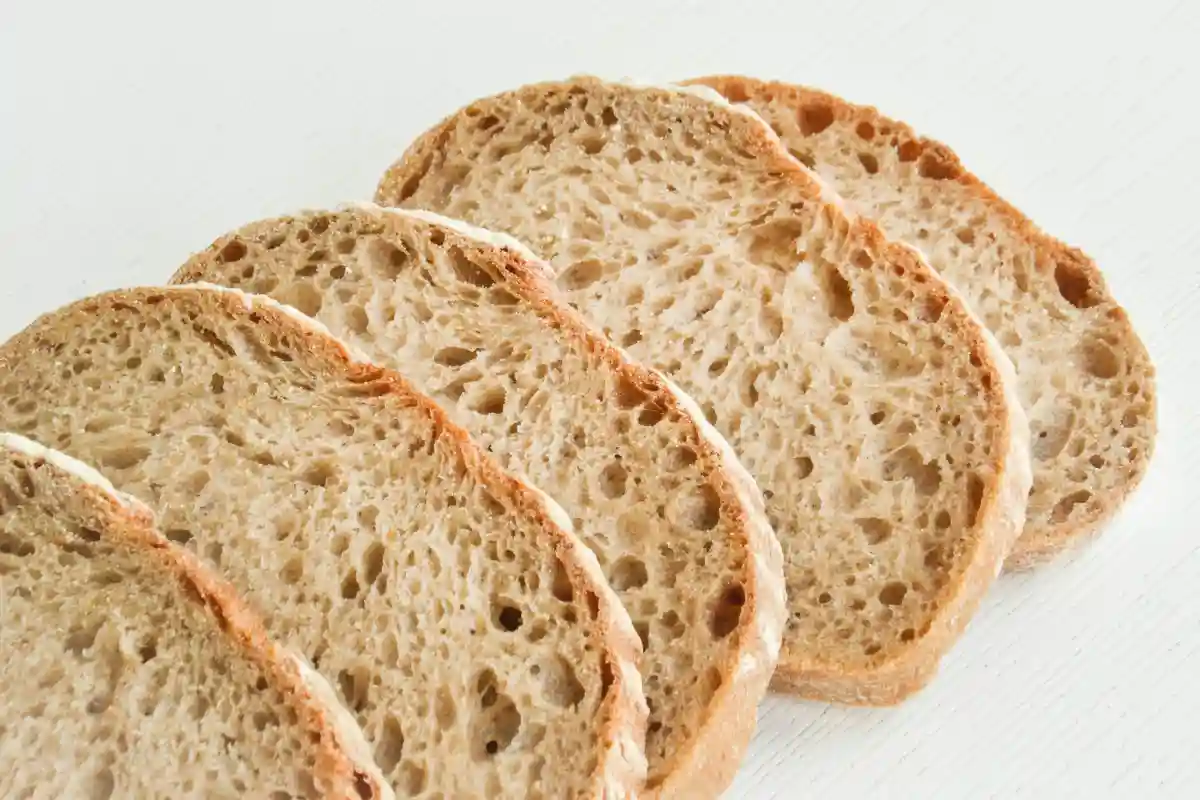
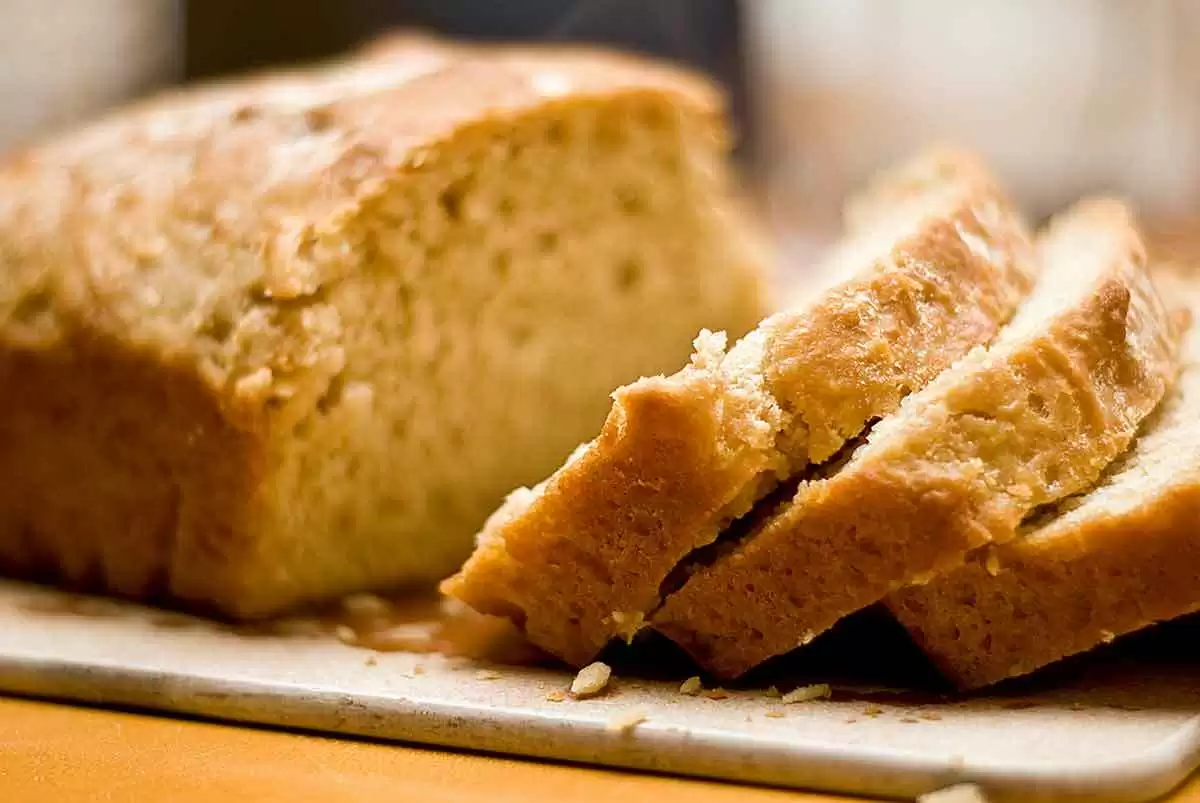



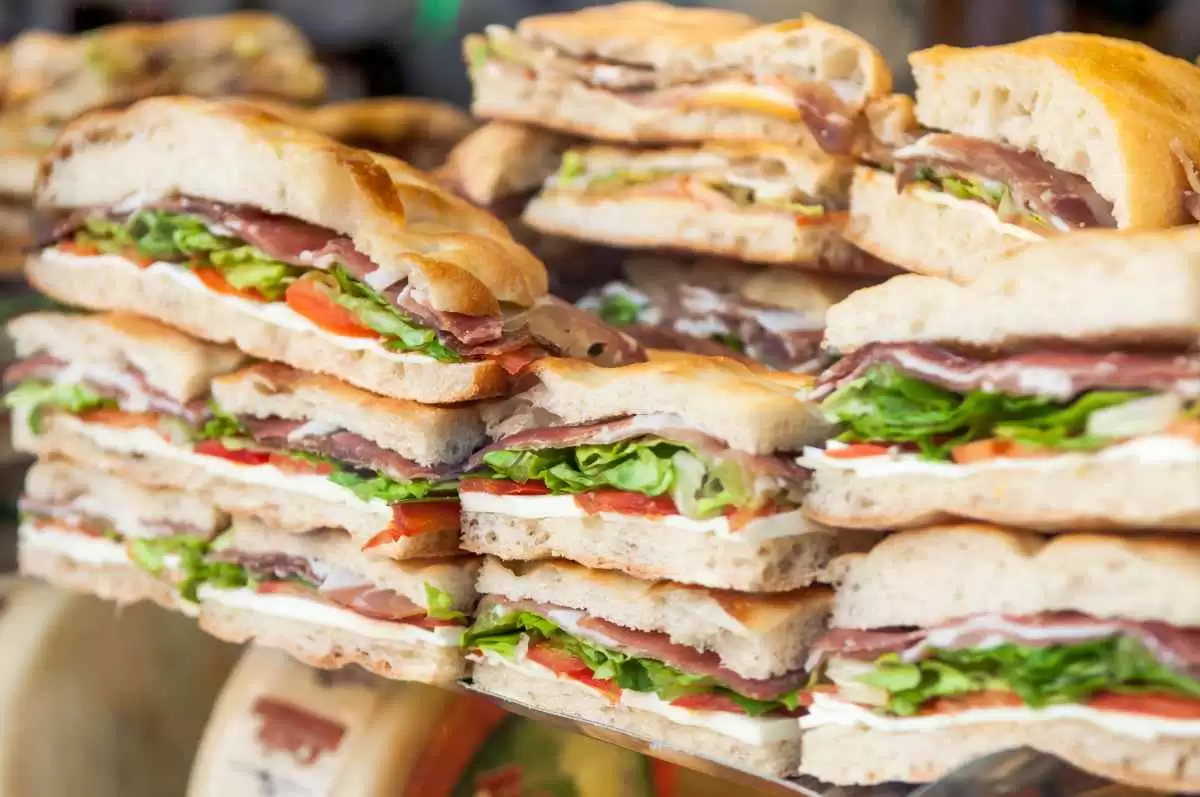

.webp.6e7bbbf8793807aefc1e09163e1cb79c.webp)

